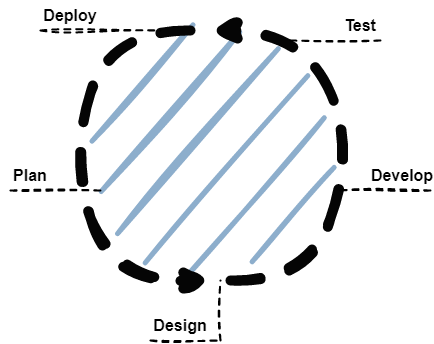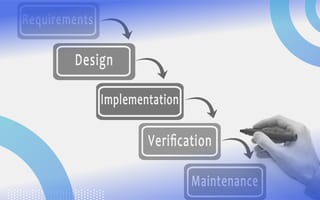The waterfall methodology is an approach used by software and product development teams manage projects. The methodology separates the different parts of the project into phases specifying the necessary activities and steps. For example, at the beginning of the project, the waterfall methodology focuses on gathering all requirements from stakeholders that project team members will later use to design and implement the product.
However, waterfall has its, well…downfalls, which I’ll discuss in more detail below. In short, waterfall may not be suitable for every development process and you can find modified or extended versions of the waterfall methodology that try to solve some of these issues.
One example of an extended version of the waterfall methodology is the V-model. A key distinction of the V-model from the original Waterfall methodology is its emphasis on validation and testing during the entire project duration, as opposed to only testing after an implementation phase.
What Is the Waterfall Methodology in Software Engineering?
The waterfall methodology is a software development life cycle (SDLC) model used to build software projects.
One thing that distinguishes waterfall from other SDLC models (like Agile) is that phases are performed sequentially. In other words, the project team must complete each phase in a specific order. If you look at the diagram below, you can see the flow is similar to a waterfall.

Working with SDLC models often includes additional software to keep track of planning, tasks and more. So it’s possible to find tools designed to support the waterfall methodology’s specific workflow, for example.
What Are the Different Phases of the Waterfall Methodology?
The waterfall methodology was one of the first established SDLC models. In fact, waterfall dates back to 1970 when Dr. Winston W. Royce described it in “Managing the Development of Large Software Systems.” However, we should note that Royce didn’t refer to the methodology as “waterfall” in the paper. The waterfall nomenclature came later. In his original paper, Royce specified the following phases.
7 Stages of the Waterfall Model
- System requirements
- Software requirements
- Analysis
- Program design
- Coding
- Testing
- Operations
The system and software requirement phase involves gathering and documenting the requirements defining the product. This process typically involves stakeholders such as the customer and project managers. The analysis phase involves steps such as analyzing the requirements to identify risks and documenting strategies.
The design phase focuses on designing architecture, business logic and concepts for the software. The design phase is followed by the coding phase which involves writing the source code for the software based on the planned design.
The testing phase concerns testing the software to ensure it meets expectations. The last phase, operations, involves deploying the application as well as planning support and maintenance.
Advantages of the Waterfall Methdology
Waterfall provides a systematic and predictable framework that helps reconcile expectations, improve planning, increase efficiency and ensure quality control. What’s more, waterfall documentation provides an entry for people outside the project to build on the software without having to rely on its creators, which is helpful if you need to bring in external assistance or implement changes to the project team.
Disadvantages of the Waterfall Methodology
The structural limitations of the waterfall methodology may introduce some problems for projects with many uncertainties. For instance, the methodology’s linear flow requires that each phase be completed before moving on to the next, which means the methodology doesn’t support revisiting and refining data based on new information that may come later in the project life cycle. A specific example of this limitation is the methodology’s focus on defining all requirements at the beginning of the project. After all, stakeholders may not know everything about the project at the very start or they may change their opinion later about what the product should actually do or what customer segment they’re trying to serve.
On the other hand, a project with well-defined and stable requirements may benefit from waterfall because it ensures the establishment and documentation of the requirements as soon as possible.
Another disadvantage of the waterfall methodology can be the late implementation of the actual software, which may result in a product not correlating with stakeholders’ expectations. For example, if the developers have misunderstood the customer’s idea about a specific feature due to poorly defined requirements, the final product will not behave as expected. Late testing can also lead to finding systemic problems too late in the project’s development when it’s more difficult to correct the design.
Waterfall Methodology vs. Agile
Another approach to software development is the Agile methodology. Agile is more flexible and open to changes than waterfall, which makes Agile more suitable for projects affected by rapid changes.

A key difference between the two methodologies is the project’s flow. While waterfall is a linear and sequential approach, Agile is an iterative and incremental approach. In practice this means that software created using Agile has development phases we perform several times with smaller chunks of implemented functionality.
The two methodologies also have different approaches to testing. The waterfall methodology tests implementation very late in the process while Agile integrates tests for each iteration.
Another key difference is the two methodologies’ approach to stakeholders. When we use waterfall, the customer doesn’t see the implemented software until quite late in the project. When we use Agile, customers have the opportunity to follow the progress along the way.
Which methodology you choose will come down to the project’s context. Stable and well-defined projects may benefit more from the waterfall methodology and other projects affected by rapid changes may benefit more from Agile.





